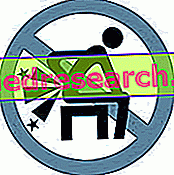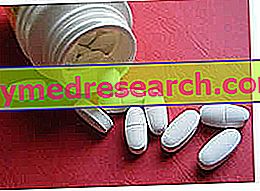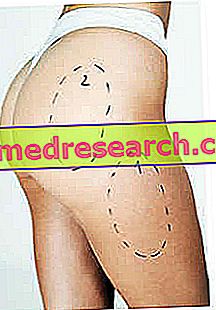Watch the video
X Watch the video on youtubeDefinition and Symptoms
The blow of the witch is an episode of acute low back pain that manifests itself with a particularly intense pain localized in the lower back.

In this way the aching and excessively contracted muscles are able to gradually relax until they allow the first movements to resume after a few hours.
Some people unaware of the danger that such a gesture could create, instead of seeking the conditions of maximum immobility to rest the musculature, tend to get up immediately with a rather abrupt movement. This approach is obviously not recommended, as it could cause further injury both at the muscular and osteoarticular level.
These are the symptoms and the phases that characterize the stroke of the witch, a sudden and dry trauma that resolves itself within 2 or 3 days but that then requires a much longer period for the complete disappearance of the pain.
Compared to low back pain, the witch's stroke is a rarer event but much more painful and excruciating.
To learn more: Symptoms Stroke of the Witch
Causes of the witch's stroke
The blow of the witch is therefore a particularly traumatic event, a sneaky enemy, always lurking, which strikes when least is expected. Most often it occurs due to unusual, forced, too intense or poorly controlled movements.
One of the situations most at risk is bending down to pick up a fallen object by making an apparently banal movement that actually causes abnormal or excessive paravertebral musculature. When you get up from the bed in the morning, the muscles in this area can be contracted excessively, for example, due to a trivial cold shot, wrong positions taken during rest or efforts made the day before and not yet recovered.
From a physiological point of view, the causes of the witch's stroke are to be found, in addition to the lack of elasticity of the paravertebral musculature, in pathologies that affect the vertebral structures present in this area.
To understand the causes for which the witch's blow arises, one must first realize that contracture is a defensive act that the body adopts to avoid far more serious consequences (stretching). When we stretch a muscle excessively an involuntary mechanism triggers which leads to the contraction of the muscle fibers. In this way, if on the one hand damage from excessive elongation is avoided, on the other, equally negative consequences may arise, such as the contraction or the blow of the witch.
Obviously the greater the elasticity of the paravertebral musculature and the lesser the possibility of being affected by this episode of acute lumbago. On the contrary, if the muscle fibers are already physiologically contracted, a minimum stretch will be enough to unleash the stretch reflex and, together with this, the sorrowful blow of the witch.
In light of this information it is possible to draw up a list of risk conditions that predispose the subject to the witch's stroke:
spoiled postural attitudes, incorrect lifting technique
other traumatic events such as falls or accidents
cold spells, lack of general and specific heating
strains involving excessive muscular and ligament stresses
spondylolisthesis (slipping of one vertebra on the other with greater)
general discopathy, herniated disc, dehydration
vertebral arthrosic degeneration
What to do if you have low back pain?
If you are struck by the fearsome blow of the witch it is advisable to stay in the so-called analgesic position first. This attitude is absolutely spontaneous and corresponds to the position in which the trauma was felt.
Rest is initially the most effective therapy, but should definitely not last beyond 12-48 hours depending on the extent of the trauma. In particular the patient should bear in mind that excessive rest is a sometimes unavoidable side effect. In conditions of immobility the musculature in fact tends to weaken becoming even more incapable of bearing the numerous stresses to which it is subjected.
Therefore, avoiding incongruous movements, it is advisable, after a few hours of complete rest, to try to mobilize the lumbar area a little at a time, perhaps by gently massaging it or applying warm compresses.
All the suggestions we will list below undoubtedly have a modest effectiveness in speeding up the return to daily activities. However they are absolutely not able to protect the individual from any recurrences that can be prevented only by improving postural attitudes and associating them with a program of targeted physical activity.
Early rehabilitation operations are based on the assumption that a contracture must be cured simply by finding the best way to relax the muscles.
After the first, short, absolute rest period, manipulations and decontracting massages, obviously performed by expert personnel, are undoubtedly effective in relieving muscle tension and bringing benefits even to analgesic level.
Non-steroidal anti-inflammatory ointments (NSAIDs) have a modest efficacy since they are absorbed much more slowly than tablets. However, their side effects are minimal and for this reason, unlike tablets, they can be purchased without a prescription. Even a simple aspirin could have some beneficial effect, as well as transdermal patches. All these tools must however only be used under medical prescription, useless and many times harmful, use "do it yourself" remedies or listen to the advice of incompetent people on the subject.
The intervention of physiotherapists, massophysiotherapists, masseurs, agupontors, osteopaths, chiropractors and so on and so forth, is certainly useful as long as you have the certainty that the staff you are addressing to is absolutely prepared and competent. Column manipulations are a potentially dangerous discipline that could have beneficial effects only for the portfolio of those who practice them.
Similar discourse for physical therapies in which we try to exploit physical agents (heat, cold, electric current) for their analgesic, anti-inflammatory and curative effect. Among the most used we mention laser therapy, electrotherapy and cryotherapy.
In a second phase, rehabilitation can continue in the gym under the guidance of an experienced personal trainer and with the help of special benches such as the inversion ones that allow the reacquisition and gradual improvement of muscle elasticity.
While in adults the stroke of the witch is often linked to causes of muscular and ligamentous origin, as one advances with age the risk of such episodes hiding much more serious problems than simple muscle contraction increases.
For this reason it is first necessary to understand what the real causes of low back pain are, both to avoid further complications and to establish a more effective therapeutic approach. If vertebral problems are already known when the witch's stroke is felt, it is essential to undergo diagnostic tests after a few days to highlight problems such as inflammation, injury, arthritis or arthrosis.
CONTINUE: Witch's Strike, Prevention and Physical Activity "



